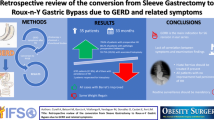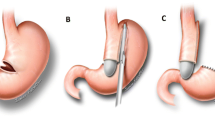Abstract
Background
Gastroesophageal reflux disease (GERD) and hiatal hernia (HH) are classically considered contraindications to bariatric restrictive procedures. Despite the high number of studies that have been published, the relationship between laparoscopic adjustable gastric banding (LAGB) and GERD/HH is still not clear.
Methods
We have retrospectively analyzed the outcomes of LAGB in patients operated in 2010 with HH and/or GERD. The gastroesophageal reflux was diagnosed if the patients had heartburn and regurgitation more than once a week, and hiatal hernia was assessed by esophagogastroduodenoscopy and/or upper GI radiogram with swallow. Data on heartburn, assumption of antacid medication, weight loss, and rate of complications in both patients with and without GERD or HH were collected.
Results
One hundred and twenty patients that underwent LAGB at our department were enrolled in our study; 40 had symptoms of GERD and 25 had hiatal hernia preoperatively. There was no difference of percentage excess weight loss (%EWL) at 12 months (45.4 ± 20.4 vs 4.6 ± 19.5 kg/m2) and 36 months follow-up (49.4 ± 16.5 vs 48.6 ± 18.9 kg/m2) between asymptomatic patients and patients with HH or GERD symptoms. The number of patients with preoperative heartburn (40 to 10) and/or assumption of antacid drugs (38 to 7) significantly decreased after LAGB
Conclusions
LAGB is an effective and safe surgical treatment for morbidly obesity in patients with GERD or HH, since it induces both a significant weight loss and an improvement of reflux symptoms.

Similar content being viewed by others
References
Wilson LJ, Ma W, Hirschowitz BI. Association of obesity with hiatal hernia and esophagitis. Am J Gastroenterol. 1999;94(10):2840–4.
O'Brien PE, MacDonald L, Anderson M, et al. Long-term outcomes after bariatric surgery: fifteen-year follow-up of adjustable gastric banding and a systematic review of the bariatric surgical literature. Ann Surg. 2013;257(1):87–94.
Morino M, Toppino M, Garrone C. Disappointing long-term results of laparoscopic adjustable silicone gastric banding. Br J Surg. 1997;84(6):868–9.
Westling A, Bjurling K, Ohrvall M, et al. Silicone-adjustable gastric banding: disappointing results. Obes Surg. 1998;8(4):467–74.
Forsell P, Hallerback B, Glise H, et al. Complications following Swedish adjustable gastric banding: a long-term follow-up. Obes Surg. 1999;9:11–6.
Greenstein RJ, Nissan A, Jaffin B. Esophageal anatomy and function in laparoscopic gastric restrictive bariatric surgery: implications for patient selection. Obes Surg. 1998;8:199–206.
Katz PO, Gerson LB, Vela MF. Guidelines for the diagnosis and management of gastroesophageal reflux disease. Am J Gastroenterol. 2013;108:308–28. doi:10.1038/ajg.2012.444.
Canon CL, Morgan DE, Einstein DM, et al. Surgical approach to gastroesophageal reflux disease: what the radiologist needs to know. Radiographics. 2005;25(6):1485–99.
Angrisani L, Di Lorenzo N, Favretti F, et al. Italian Collaborative Study Group for LAP-BAND. The Italian Group for LAP-BAND: predictive value of initial body mass index for weight loss after 5 years of follow-up. Surg Endosc. 2004;18(10):1524–7.
Angrisani L, Favretti F, Furbetta F, et al. Italian Group for lap-band system: results of multicenter study on patients with BMI < or =35 kg/m2. Obes Surg. 2004;14(3):415–8.
Pilone V, Mozzi E, Schettino AM, et al. Improvement in health-related quality of life in first year after laparoscopic adjustable gastric banding. Surg Obes Relat Dis. 2012;8(3):260–8.
Busetto L, Pilone V, Schettino AM, et al. Determinants of health-related quality of life in morbid obese candidates to gastric banding. Eat Weight Disord. 2012;17(2):e93–100.
Khan A, Ren-Fielding C, Traube M. Potentially reversible pseudoachalasia after laparoscopic adjustable gastric banding. J Clin Gastroenterol. 2011;45(9):775–9.
Burton PR, Brown WA. The mechanism of weight loss with laparoscopic adjustable gastric banding: induction of satiety not restriction. Int J Obes (Lond). 2011;35 Suppl 3:S26–30.
Burton PR, Brown WA, Laurie C, et al. Mechanisms of bolus clearance in patients with laparoscopic adjustable gastric bands. Obes Surg. 2010;20(9):1265–72.
Burton PR, Brown W, Laurie C, et al. Outcomes, satiety, and adverse upper gastrointestinal symptoms following laparoscopic adjustable gastric banding. Obes Surg. 2011;21:574–81.
Robert M, Golse N, Espalieu P, et al. Achalasia-Like Disorder After Laparoscopic Adjustable Gastric Banding: a Reversible Side Effect? Obes Surg. 2012;22:704–11.
O'Rourke RW, Seltman AK, Chang EY, et al. A model for gastric banding in the treatment of morbid obesity: the effect of chronic partial gastric outlet obstruction on esophageal physiology. Ann Surg. 2006;244(5):723–33.
Azagury DE, Varban O, Tavakkolizadeh A, et al. Does laparoscopic gastric banding create hiatal hernias? Surg Obes Relat Dis. 2013;9(1):48–52.
Angrisani L, Iovino P, Lorenzo M, et al. Treatment of morbid obesity and gastroesophageal reflux with hiatal hernia by lap-band. Obes Surg. 1999;9:396–8.
Dixon JB, O’Brien PE. Gastroesophageal reflux in obesity: the effect of lap-band placement. Obes Surg. 1999;9:527–31.
Iovino P, Angrisani L, Tremolaterra F, et al. Abnormal esophageal acid exposure is common in morbidly obese patients and improves after successful Lap-band system implantation. Surg Endosc. 2001;16:1631–5.
Pilone V, Di Micco R, Monda A, et al. Positive findings in preoperative testing prior to gastric banding: their real value. Minerva Chir. 2013;68(6):529–35.
Macran S, Wileman S, Barton G, et al. The development of a new measure of quality of life in the management of gastro-oesophageal reflux disease: the Reflux questionnaire. Qual Life Res. 2007;16:331–43.
Jones R, Junghard O, Dent J, et al. Development of the GerdQ, a tool for the diagnosis and management of gastro-oesophageal reflux disease in primary care. Aliment Pharmacol Ther. 2009;30(10):1030–8.
Vakil N, van Zanten SV, Kahrilas P, et al. The Montreal definition and classification of gastroesophageal reflux disease: a global evidence-based consensus. Am J Gastroenterol. 2006;101(8):1900–20.
Che F, Nguyen B, Cohen A, et al. Prevalence of hiatal hernia in the morbidly obese. Surg Obes Relat Dis. 2013;9(6):920–4.
Suter M, Dorta G, Giusti V, et al. Gastro-esophageal reflux and esophageal motility disorders in morbidly obese patients. Obes Surg. 2004;14(7):959–66.
Dolan K, Finch R, Fielding G. Laparoscopic gastric banding and crural repair in the obese patient with a hiatal hernia. Obes Surg. 2003;13(5):772–5.
Gulkarov I, Wetterau M, Ren CJ, et al. Hiatal hernia repair at the initial laparoscopic adjustable gastric band operation reduces the need for reoperation. Surg Endosc. 2008;22(4):1035–41.
Frezza EE, Barton A. Wachtel MS Crural repair permits morbidly obese patients with not large hiatal hernia to choose laparoscopic adjustable banding as a bariatric surgical treatment. Obes Surg. 2008;18(5):583–8.
Conflict of interest
All authors declare no conflict of interest in writing this article.
Author information
Authors and Affiliations
Corresponding author
Rights and permissions
About this article
Cite this article
Pilone, V., Vitiello, A., Hasani, A. et al. Laparoscopic Adjustable Gastric Banding Outcomes in Patients with Gastroesophageal Reflux Disease or Hiatal Hernia. OBES SURG 25, 290–294 (2015). https://doi.org/10.1007/s11695-014-1366-z
Published:
Issue Date:
DOI: https://doi.org/10.1007/s11695-014-1366-z




